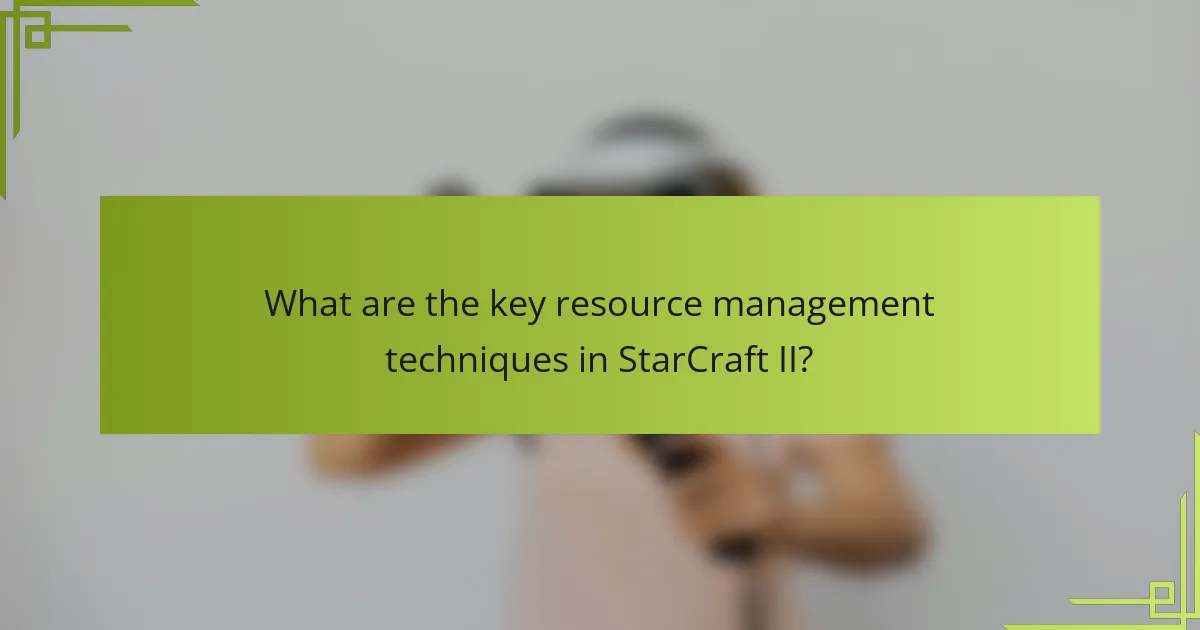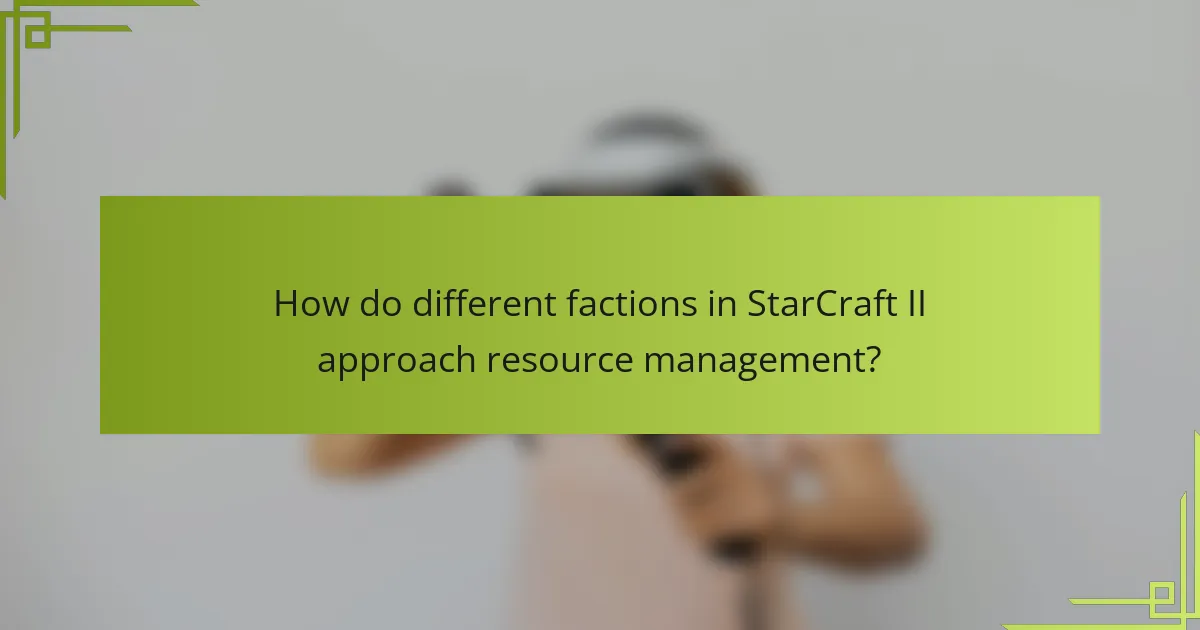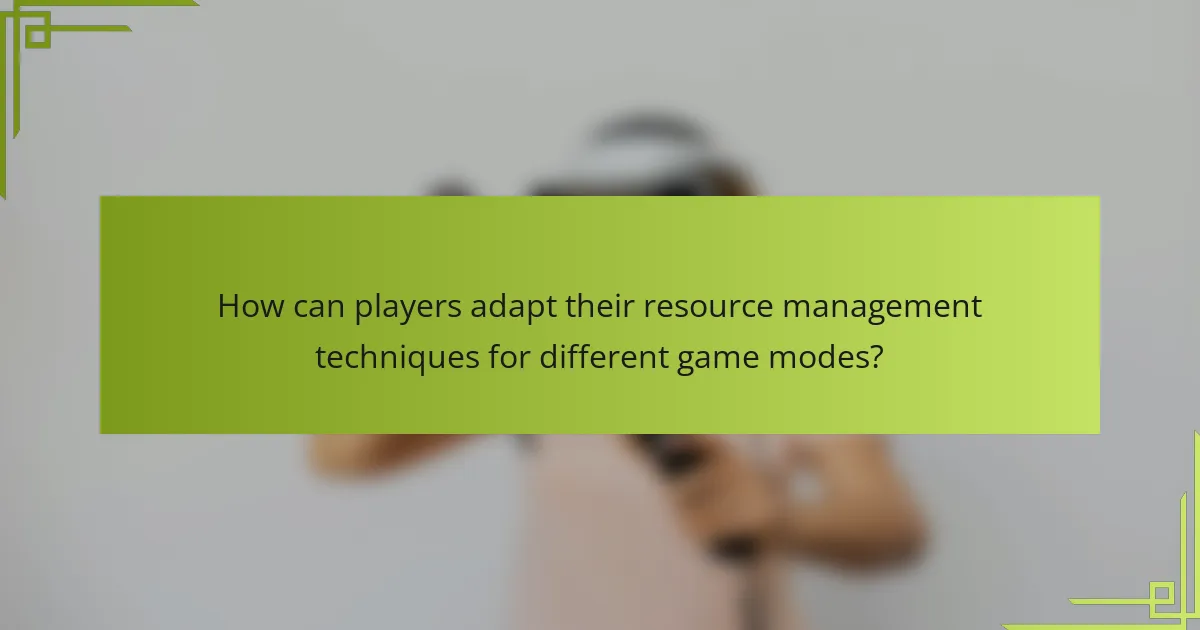Mastering resource management techniques in StarCraft II is essential for competitive success. This article explores efficient mining, unit production optimization, and strategic resource allocation. It also highlights the importance of community engagement, common challenges players face, and advanced methods to enhance gameplay. Understanding faction-specific strategies can further optimize resource management and improve overall performance.

What are the key resource management techniques in StarCraft II?
StarCraft II players utilize several key resource management techniques to enhance competitive performance. Effective techniques include efficient mining, unit production optimization, and strategic resource allocation.
Efficient mining focuses on maximizing mineral and gas collection by positioning workers optimally and minimizing travel time. Unit production optimization involves balancing the creation of combat units and economy-building structures to ensure a steady supply of resources. Strategic resource allocation emphasizes prioritizing upgrades and tech paths that align with the player’s strategy, allowing for adaptability in response to opponents.
Additionally, players often employ scouting to gather information about their opponent’s resource management, which informs their own decisions. Mastering these techniques can significantly influence the outcome of matches in the competitive StarCraft II community.
How does effective resource allocation impact gameplay?
Effective resource allocation significantly enhances gameplay by optimizing unit production and strategic decision-making. Players who master resource management can maintain a competitive edge, ensuring timely upgrades and efficient army compositions. This leads to better engagement in the competitive community, as skilled players often set benchmarks for others. Additionally, effective allocation minimizes resource wastage, allowing for sustained pressure on opponents and improved chances of victory.
Which strategies maximize resource gathering efficiency?
To maximize resource gathering efficiency in StarCraft II, players should focus on strategic building placement, unit production optimization, and effective scouting. Prioritizing early worker production enhances resource collection rates.
Utilizing a balanced mix of workers and military units ensures sustained resource flow while deterring enemy advances. Implementing efficient expansion strategies allows for increased resource access, particularly in high-yield zones.
Adapting to opponent strategies through scouting provides insights for timely resource allocation and unit production adjustments. This proactive approach can significantly enhance overall resource management effectiveness.

How do different factions in StarCraft II approach resource management?
Different factions in StarCraft II employ distinct resource management techniques to optimize their gameplay. Terran players focus on efficient unit production and expansion while utilizing structures for resource gathering. Zerg players emphasize rapid expansion and swarm tactics, capitalizing on their ability to produce units quickly. Protoss players rely on advanced technology and strategic upgrades, often prioritizing resource allocation for powerful units. Each faction’s approach reflects their unique strengths and influences competitive strategies.
What unique resource strategies do Terran players utilize?
Terran players utilize unique resource strategies focused on efficient unit production and strategic expansion. They prioritize early game resource gathering through SCV production and utilize mules to boost mineral income. Additionally, they often implement drop tactics to disrupt enemy resource collection while securing their own expansions.
Terran players also leverage tech advancements to optimize resource allocation, such as transitioning from bio to mech units based on opponent strategies. This adaptability allows them to maintain resource efficiency while responding to threats.
Finally, map control plays a critical role in Terran resource strategies. By establishing watch towers and controlling key locations, they can secure additional resources and deny their opponents access, enhancing their overall economic advantage.
How do Zerg players leverage their resource mechanics?
Zerg players optimize resource mechanics by focusing on efficient unit production and rapid expansion. They utilize the unique ability to spawn multiple units simultaneously, allowing for quick responses to enemy strategies.
Key techniques include prioritizing drone production to maximize mineral and gas income, leveraging the Hatchery’s ability to produce units and inject larvae efficiently. This enables Zerg players to maintain a steady flow of combat units, essential for overwhelming opponents.
Additionally, Zerg players often scout effectively to adapt their resource allocation based on enemy movements. They may invest in tech upgrades or additional expansions based on the game’s progression, ensuring they remain competitive.
This strategic resource management fosters community engagement, as players share insights and strategies to enhance their gameplay.
What are the resource management tactics of Protoss players?
Protoss players utilize various resource management tactics to maintain an efficient economy. Key techniques include early game probe production, strategic expansion timing, and effective mineral and gas allocation.
First, players prioritize building probes early to maximize resource gathering. This foundational tactic ensures a steady income of minerals and gas. Next, expanding to additional bases at the right moment allows for greater resource intake. Timing these expansions is crucial to avoid overcommitting while still pressuring opponents.
Moreover, Protoss players often employ warp gate technology to facilitate quick unit production. This technology enables them to respond rapidly to threats while managing their resources effectively. Lastly, balancing the ratio of mineral and gas units is vital. Players must decide when to invest in high-tech units versus maintaining a strong ground army.
Overall, these tactics contribute to a robust economic strategy, allowing Protoss players to sustain competitive engagement in StarCraft II.

Why is community engagement crucial for competitive StarCraft II players?
Community engagement is crucial for competitive StarCraft II players as it fosters collaboration, skill improvement, and strategic insights. Engaging with the community allows players to share resources, discuss tactics, and receive feedback on their gameplay. This interaction enhances their resource management techniques, vital for mastering in-game economy and unit production.
Participating in forums, streaming platforms, and local tournaments cultivates a support network. Players gain access to diverse strategies and perspectives, which can lead to unique gameplay adaptations. Moreover, community-driven events often highlight rare techniques that can provide a competitive edge.
Establishing a strong presence in the community can also lead to sponsorship opportunities and collaborations with other players. These relationships can amplify a player’s visibility and credibility in the competitive scene. Engaging with fans and fellow gamers creates a positive feedback loop that motivates continuous improvement and innovation in gameplay strategies.
How can players build a supportive community around resource management techniques?
Players can build a supportive community around resource management techniques by sharing strategies, offering feedback, and collaborating. Engaging in forums and social media groups fosters knowledge exchange. Hosting workshops or streams enhances learning and connection. Encouraging positive reinforcement strengthens community bonds. Regular discussions on best practices keep members motivated and informed.
What role do online platforms play in fostering community collaboration?
Online platforms significantly enhance community collaboration in StarCraft II by providing resources and tools for effective engagement. These platforms facilitate knowledge sharing, strategy discussions, and resource management techniques among players. They allow users to collaborate on strategies, share gameplay insights, and develop community-driven content. This interaction fosters a competitive environment where players can refine their skills and improve their performance. The ability to access diverse perspectives and strategies enriches the community experience, ultimately leading to a more vibrant and engaged player base.

Which common challenges do players face in resource management?
Players face several common challenges in resource management within StarCraft II. Key difficulties include maintaining a balanced economy, managing supply limits, and optimizing resource allocation. These challenges can hinder performance and strategic execution.
Inefficient resource gathering can lead to shortages, impacting unit production and technology upgrades. Players often struggle with multitasking, which is crucial for effective resource management. Additionally, adapting to opponents’ strategies can complicate resource decisions, requiring quick adjustments to sustain competitiveness.
Time management is another significant challenge; players must efficiently allocate time between gathering resources and executing strategic maneuvers. Lastly, understanding the map and resource locations can influence decision-making, making map awareness essential for success.
What are the most frequent mistakes in resource allocation?
Frequent mistakes in resource allocation for StarCraft II include underestimating resource needs, neglecting upgrades, failing to scout opponents, overcommitting to one unit type, and mismanaging worker production. These errors can significantly hinder competitive performance.
Underestimating resource needs often leads to insufficient army strength during critical engagements. Neglecting upgrades can result in weaker units compared to opponents. Failing to scout limits awareness of enemy strategies, leading to misallocation of resources. Overcommitting to one unit type creates vulnerabilities against diverse enemy compositions. Mismanaging worker production can stall economic growth, impacting long-term strategy.
How can players overcome resource scarcity during matches?
Players can overcome resource scarcity during matches by implementing effective resource management techniques. Prioritize expanding your economy early in the game to secure a steady flow of resources. Focus on scouting to gather intelligence on your opponent’s strategy, allowing you to adapt your resource allocation accordingly. Utilize worker production efficiently to maximize resource collection, and consider building additional bases to increase your resource intake. Lastly, practice strategic spending to ensure you invest in units and upgrades that will provide the most value in the current match context.

What advanced techniques can enhance resource management skills?
Utilizing advanced techniques can significantly enhance resource management skills in StarCraft II. Key methods include efficient macro management, effective unit production, and strategic resource allocation.
1. Prioritize macro mechanics to maintain a steady economy.
2. Optimize building placement for resource gathering efficiency.
3. Implement hotkeys for rapid unit production and management.
4. Analyze opponent strategies to adjust resource allocation dynamically.
5. Utilize in-game timers to track resource collection rates.
How does analyzing replays contribute to better resource management?
Analyzing replays significantly enhances resource management in StarCraft II by identifying inefficiencies and optimizing strategies. Players can pinpoint mistakes in resource allocation, such as overcommitting to units or neglecting expansions. This analysis helps in understanding opponent strategies, allowing for better counterplay and resource distribution. Additionally, players can refine their build orders, ensuring that resources are spent effectively throughout the match, leading to improved performance in competitive environments.
Which tools and software assist in optimizing resource strategies?
Tools and software for optimizing resource strategies in StarCraft II include resource management applications, build order planners, and performance analysis tools. These tools enhance strategic decision-making and improve competitive engagement.
Resource management applications track in-game resources and provide real-time analysis. Build order planners help players design efficient strategies, optimizing unit production and resource allocation. Performance analysis tools analyze gameplay data, offering insights into resource usage and strategic effectiveness.
Using these tools, players can refine their gameplay, adapt strategies based on performance metrics, and engage more effectively with the competitive community.

How can players adapt their resource management techniques for different game modes?
Players can adapt their resource management techniques by tailoring strategies to each game mode’s demands. In competitive play, efficient resource allocation is crucial for maximizing unit production and tech advancements.
In 1v1 matches, players should focus on scouting and responding to opponents’ strategies to optimize resource distribution. For team games, communication and collective resource sharing can enhance overall performance.
Players might also consider adjusting their build orders based on the game mode’s pacing. In faster modes, prioritizing early-game units can provide a strategic advantage, while slower modes may allow for more extensive tech development.
Lastly, understanding the unique attributes of each faction in StarCraft II can inform resource management decisions, ensuring players leverage their strengths effectively.
What adjustments are necessary for 1v1 matches versus team games?
1v1 matches require more focused resource management than team games. In 1v1 scenarios, players must optimize individual unit production, tech advancement, and economy without relying on teammates. Key adjustments include prioritizing early-game expansion to secure resources, managing unit composition to counter opponents effectively, and maintaining constant scouting to adapt strategies. Team games, conversely, allow for shared resources and strategic coordination, enabling players to diversify roles and responsibilities. This necessitates a different approach to resource allocation, emphasizing synergy and communication among team members.
How do resource strategies differ in casual play versus competitive tournaments?
Resource strategies in casual play focus on exploration and enjoyment, while competitive tournaments emphasize efficiency and optimization. Casual players may prioritize resource gathering at their own pace, while competitive players must manage resources under pressure to maximize unit production and strategy execution. Competitive play often involves precise timing and map control to secure resource locations, contrasting with the more relaxed approach in casual settings. Additionally, competitive players analyze opponents’ strategies to adapt their resource management, enhancing their decision-making skills.

What best practices should players follow for effective resource management?
Effective resource management in StarCraft II requires players to prioritize efficient gathering, strategic spending, and timely upgrades. Focus on these best practices:
1. Optimize worker production to maintain a steady income.
2. Balance resource allocation between units, buildings, and upgrades.
3. Scout opponents to adapt your strategy based on their resource management.
4. Use hotkeys for quick access to production facilities, enhancing efficiency.
5. Manage supply effectively to avoid production delays.
6. Practice macro techniques to improve multitasking and resource flow.
Implementing these techniques enhances competitiveness and fosters community engagement.
Which expert tips can improve resource allocation efficiency?
Effective resource allocation in StarCraft II involves prioritizing unit production, managing supply efficiently, and optimizing mineral and gas usage. Focus on early game expansion and scouting to identify resource opportunities.
1. Prioritize unit production based on opponent strategies.
2. Expand early to increase resource intake.
3. Scout regularly to gather intelligence on enemy movements.
4. Balance mineral and gas expenditure for unit composition.
5. Use hotkeys for quick access to production buildings.
What common pitfalls should be avoided in resource management?
To avoid common pitfalls in resource management for StarCraft II, players should focus on three key areas: overcommitting resources, neglecting unit production, and failing to adapt strategies.
Overcommitting resources often leads to a lack of flexibility. Players should balance between investing in economy and maintaining an effective army. Neglecting unit production can leave players vulnerable to enemy attacks. Consistently producing units is crucial for maintaining pressure and defense. Lastly, failing to adapt strategies can result in predictable gameplay. Players must assess opponents’ tactics and adjust their resource allocation accordingly to stay competitive.